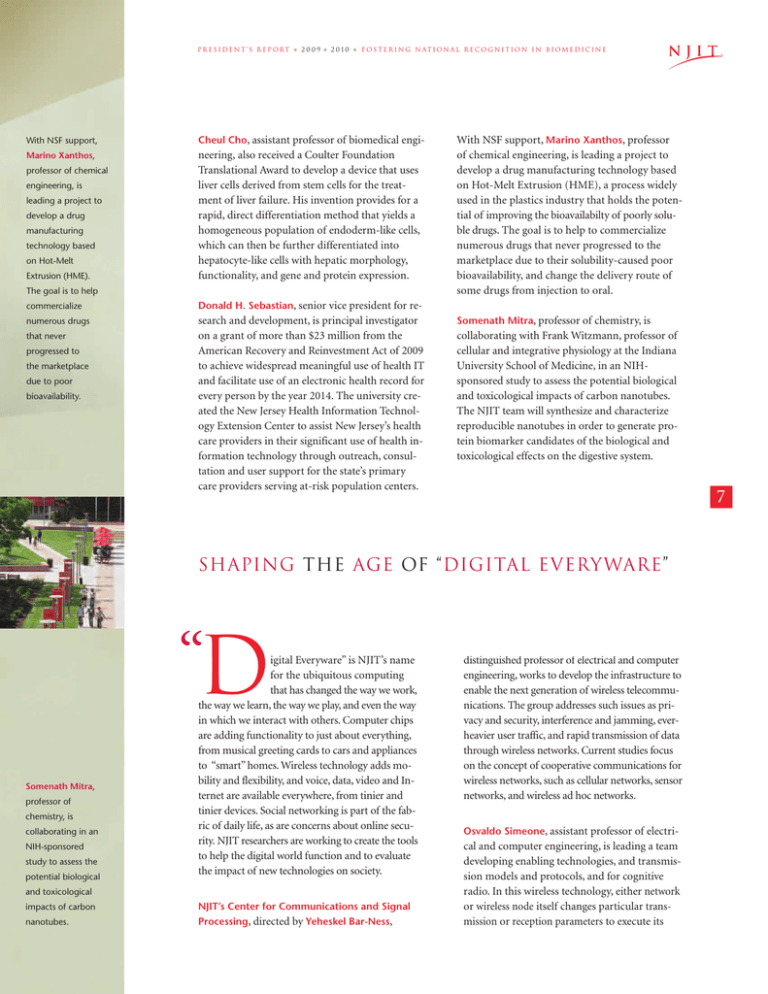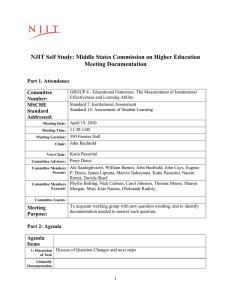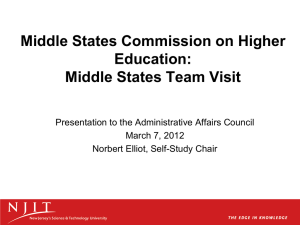Document 13178258
advertisement

P r e s i d e n t ’s R e p ort ■ 2009 ■ 2010 ■ F o s t e r i n g N at i o n a l R E c o g n i t i o n i n B i o m e d i c i n e With NSF support, Cheul Cho, assistant professor of biomedical engi- Marino Xanthos, neering, also received a Coulter Foundation Translational Award to develop a device that uses liver cells derived from stem cells for the treatment of liver failure. His invention provides for a rapid, direct differentiation method that yields a homogeneous population of endoderm-like cells, which can then be further differentiated into hepatocyte-like cells with hepatic morphology, functionality, and gene and protein expression. professor of chemical engineering, is leading a project to develop a drug manufacturing technology based on Hot-Melt Extrusion (HME). The goal is to help commercialize numerous drugs that never progressed to the marketplace due to poor bioavailability. Donald H. Sebastian, senior vice president for research and development, is principal investigator on a grant of more than $23 million from the American Recovery and Reinvestment Act of 2009 to achieve widespread meaningful use of health IT and facilitate use of an electronic health record for every person by the year 2014. The university created the New Jersey Health Information Technology Extension Center to assist New Jersey’s health care providers in their significant use of health information technology through outreach, consultation and user support for the state’s primary care providers serving at-risk population centers. With NSF support, Marino Xanthos, professor of chemical engineering, is leading a project to develop a drug manufacturing technology based on Hot-Melt Extrusion (HME), a process widely used in the plastics industry that holds the potential of improving the bioavailabilty of poorly soluble drugs. The goal is to help to commercialize numerous drugs that never progressed to the marketplace due to their solubility-caused poor bioavailability, and change the delivery route of some drugs from injection to oral. Somenath Mitra, professor of chemistry, is collaborating with Frank Witzmann, professor of cellular and integrative physiology at the Indiana University School of Medicine, in an NIHsponsored study to assess the potential biological and toxicological impacts of carbon nanotubes. The NJIT team will synthesize and characterize reproducible nanotubes in order to generate protein biomarker candidates of the biological and toxicological effects on the digestive system. 7 SHAPING THE AGE OF “DIGITAL EVERYWARE” “D Somenath Mitra, professor of chemistry, is collaborating in an NIH-sponsored study to assess the potential biological igital Everyware” is NJIT’s name for the ubiquitous computing that has changed the way we work, the way we learn, the way we play, and even the way in which we interact with others. Computer chips are adding functionality to just about everything, from musical greeting cards to cars and appliances to “smart” homes. Wireless technology adds mobility and flexibility, and voice, data, video and Internet are available everywhere, from tinier and tinier devices. Social networking is part of the fabric of daily life, as are concerns about online security. NJIT researchers are working to create the tools to help the digital world function and to evaluate the impact of new technologies on society. and toxicological impacts of carbon nanotubes. NJIT’s Center for Communications and Signal Processing, directed by Yeheskel Bar-Ness, distinguished professor of electrical and computer engineering, works to develop the infrastructure to enable the next generation of wireless telecommunications. The group addresses such issues as privacy and security, interference and jamming, everheavier user traffic, and rapid transmission of data through wireless networks. Current studies focus on the concept of cooperative communications for wireless networks, such as cellular networks, sensor networks, and wireless ad hoc networks. Osvaldo Simeone, assistant professor of electri- cal and computer engineering, is leading a team developing enabling technologies, and transmission models and protocols, and for cognitive radio. In this wireless technology, either network or wireless node itself changes particular transmission or reception parameters to execute its 8 “ D igital Everyware”is NJIT’s name for the ubiquitous computing that has changed the way we work, the way we play, and even the way we interact with others. NJIT’s School Louis Lanzerotti of Management, (below), distinguished Associate Professor research professor of Katia Passerini (above), physics, was named by investigates the atti- the National Research tudes and perceptions Council of the National that people bring to Academies of Science online learning, social and NASA to study elec- networks and even elec- tronic systems used in tronic health records. the automotive industry. P r e s i d e n t ’s R e p ort Osvaldo Simeone (far left in photo on facing page), assistant professor of electrical and computer engineering, with graduate students Tariq Elkourdi, ■ 2009 ■ 2010 ■ S h a p i n g t h e A g e of “ D i g i ta l E v e ry wa r e ” tasks efficiently without interfering with the licensed users. The team is working to address technical drawbacks in the current frameworks used in cognitive radio by introducing a novel framework of distributed spectrum leasing via cross-layer cooperation (DiSC) to guide the design of medium access control/data link (MAC/ DL) – physical layer protocols in decentralized cognitive radio networks. He hopes to gain a theoretical understanding of the approach’s potential from the standpoints of network information theory and networking theory, as well as designing protocols that effectively implement DiSC in a complex wireless environment. Namjeong Lee and Keonkook Lee, is leading a team developing enabling technologies, and transmission models and protocols, and for cognitive radio. Christian Borcea, associate professor of computer Realizing that networks in the digital age no longer require linked computers — or any computers at all — Christian Borcea, associate professor of computer science, designs software architectures and applications for large-scale mobile networks. MobiSoC is a middleware — software that connects people with individuals — for mobile social applications, which capture the social state of human communities, learn previously unknown patterns from emergent geosocial data, and share these data with applications while respecting users’ privacy concerns. The applications supported by MobiSoC run on Smart Phones and allow anytime, anywhere collaboration and coordination among community members. With an NSF grant, he is currently working on an infrastructure for mobile social computing in collaboration with the University of South Florida. Borcea is also working with Guiling Wang, assistant professor of computer science, to develop inter-vehicular networking, computing, and sensing technologies to improve driving safety. Today’s vehicles have embedded computers, GPS receivers, short-range wireless network interfaces, and potentially access to in-car sensors and the Internet. In the NSF-funded project, these would interact with road-side wireless sensor networks to warn drivers of accidents or congestion ahead, estimate potential delays, and even send a message ahead to alert others that the driver is delayed. science, designs software architectures and applications for large-scale mobile networks. From NJIT’s School of Management, Associate Professor Katia Passerini investigates the attitudes and perceptions that people bring to online learning, social networks and even electronic health records. With Starr Roxanne Hiltz, distin- guished professor emeritus of information systems, she compared the privacy concerns of members of Facebook and MySpace. They found that although members had significant concerns about privacy, they were willing to share information and meet new people and concluded that trust is not as necessary in the building of new online relationships as it is in face to face encounters. She and Diane Walsh, senior university lecturer of law, looked into current practice and concerns about privacy related to medical records, particularly electronic health records (EHRs). She and Elizabeth Gomez, senior university lecturer in information systems, considered the benefits of team-based learning and how it can be adapted to an online setting. Quentin Jones, associate professor of information systems, researches social computing and social software, particularly how various social computing system designs can both enable and constrain interpersonal and group interactions. He directs the SmartCampus project that is developing hardware and software to help students to connect better with other students and the NJIT campus. With an NSF grant, he is currently looking at interpersonal communication channels such as texting, instant messaging and mobile phone conversations to coordinate social activities, such as the planning of a future face-to-face meeting — what he terms “outeraction” — and how appropriate software could improve the process. He hopes to provide the infrastructure to improve people’s ability to engage in social activities of interest and coordinate with others in a simple way to increase social connectivity. Louis Lanzerotti, distinguished research professor of physics, was named by the National Research Council of the National Academies and NASA to study electronic systems used in the automotive industry with a view to identifying possible causes of unintended acceleration in vehicles in the aftermath of the recent large-scale recalls. The panel will look at software, computer hardware design, electromagnetic compatibility and electromagnetic interference and make recommendations to the National Highway Traffic Safety Administration. 9



